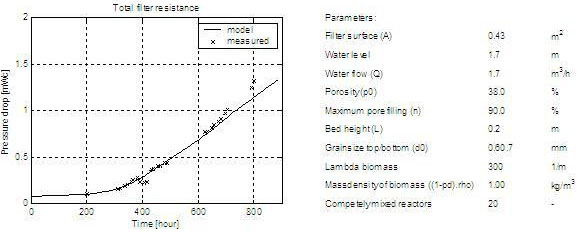Optimization of Drinking Water Treatment Processes using models and on-line monitoring tools (Techneau)
researcher: Petra Ross
Research objectives
The research objective is to develop and combine existing models for a water treatment platform, which enables users to virtually construct a water treatment plant and to monitor and optimise existing water treatment plants.
Project outline
Introduction
To achieve the objective following topics are addressed:
- a inventory of models and water quality parameters;
- incorporation of online monitoring tools;
- development of new models;
- description of a testing protocol;
- calibration and validation of the individual models and treatment trains;
Approach
An inventory of models and water quality parameters was carried out from October until December 2006. Existing water quality models written in MATLAB® Simulink were converted to c-code after which they were implemented in SimEau, European Water Treatment Simulator developed within the European 6th framework project Techneau (www.techneau.org).The development of online monitoring tools was done from January until December 2007. Biostability was determined through an on-line estimation of assimilable organic carbon (AOC). This was conducted by correlating differential UV/Vis-spectra measurements to AOC measurements. The development of new models combined with the use of online monitoring tools will be addressed in this part, whereas the description of testing protocol and the calibration and validation will be executed in future research. When ozonation is followed by biological filtration, part of the AOC formed during ozonation is biodegraded by the biomass present in the biological filters. The AOC is consumed and transferred into biomass, resulting in an increase in pressure drop over the filters, until the filters need to be backwashed. The amount of produced biomass in the filters can be directly linked to the amount of AOC present in the water. The clogging of biological activated carbon filters is modelled. In order to study clogging due to the development of biomass, different ozone dosages were applied, on pilot scale, resulting in different AOC concentrations. The pressure drop was measured at several heights in the filter bed, see Figure 1.

Figure 1 – Experimental set-up of pilot plant with sampling points
Results
The pressure build-up only took place in the top layer of the filter bed due to stratification of the filter material. The results of a model prediction for pressure drop and the actual measured pressure drop for one of the filter runs is presented in Figure 2.

Figure 2 – Model prediction filter run
The presence of biomass causes the formation of a cake layer and accounts for the majority of the pressure build up in the BAC filter. The model is used to predict the filter run time between backwashing, for both cold as warm temperature, and can be used to set backwash intervals more accurately.
Scientific relevance
To be able to develop a model, understanding of the processes involved during the treatment process is necessary. Additionally the combination of joint unit processes also gives insight in the interaction between the different processes. On-line monitoring tools can be used to calibrate and validate the models and is a tool for direct optimization of the treatment processes.
Social relevance
Direct notice of changes in the raw water quality can result in direct action and optimization of the operation of the drinking water treatment plant. Combined with the existence of a water treatment simulator comprised of models of different treatment processes this will lead to an improved operation of the drinking water treatment plant and will result in a better water quality benefiting public safety.
Literature
- Ross, PS, Helm, AWC van der, Broeke, J van den, Aa, LTJ van der & Rietveld, LC (2008). Effect of raw water quality on performance of ozone and biofiltration based on modelling and on-line monitoring. In Proceedings of WISA Conference. Sun City, South Africa
- Ross, PS, Broeke J van den &Rietveld L.C. (2008). Drinking water treatment: On-line estimation of biological stability using UV-spectrography. In: Proceedings of UV-Workshop, Vienna, Austria.
- Broeke, J van den, Ross, PS, Helm, AWC van der, Baars, ET, & Rietveld, LC (2008). Use of on-line UV/Vis-spectrometry in the measurement of dissolved ozone and AOC concentration in drinking water treatment. Water Science and Technology, 57(8), pp 1169-1175.